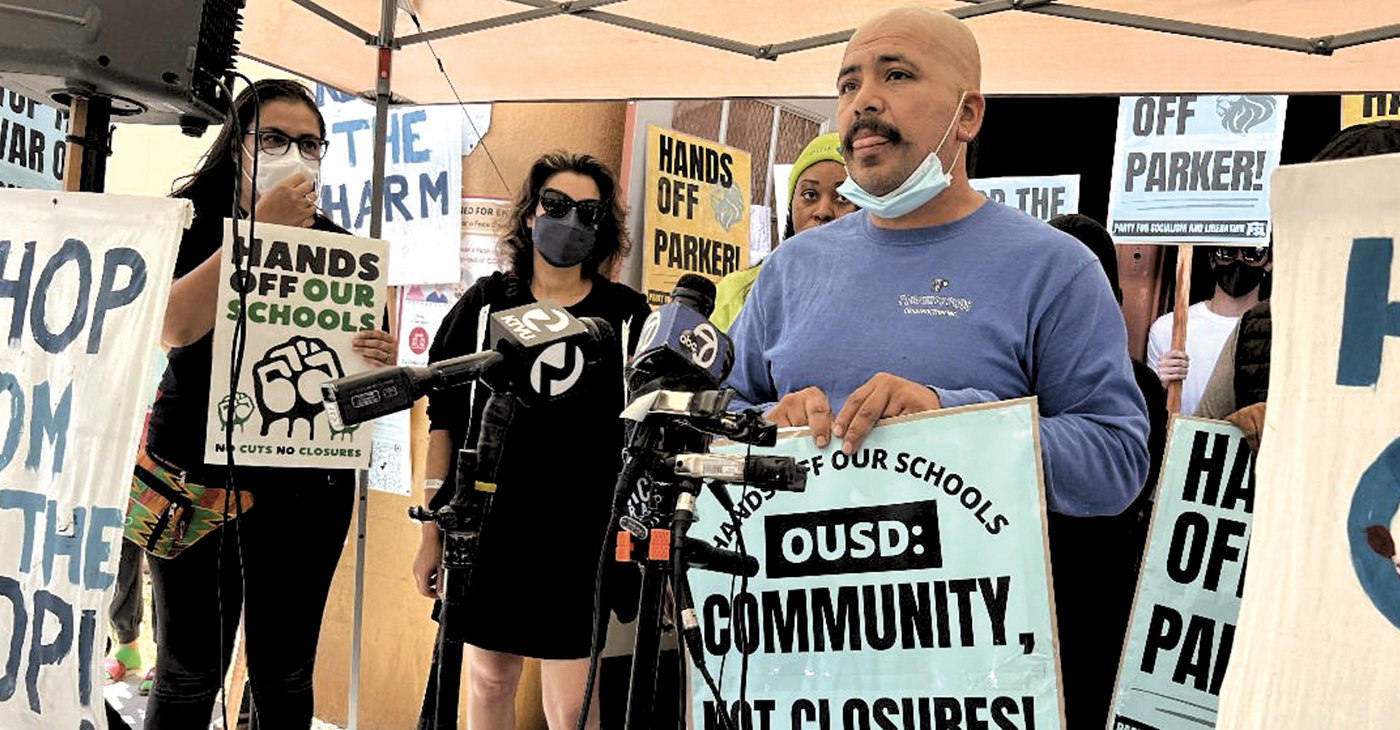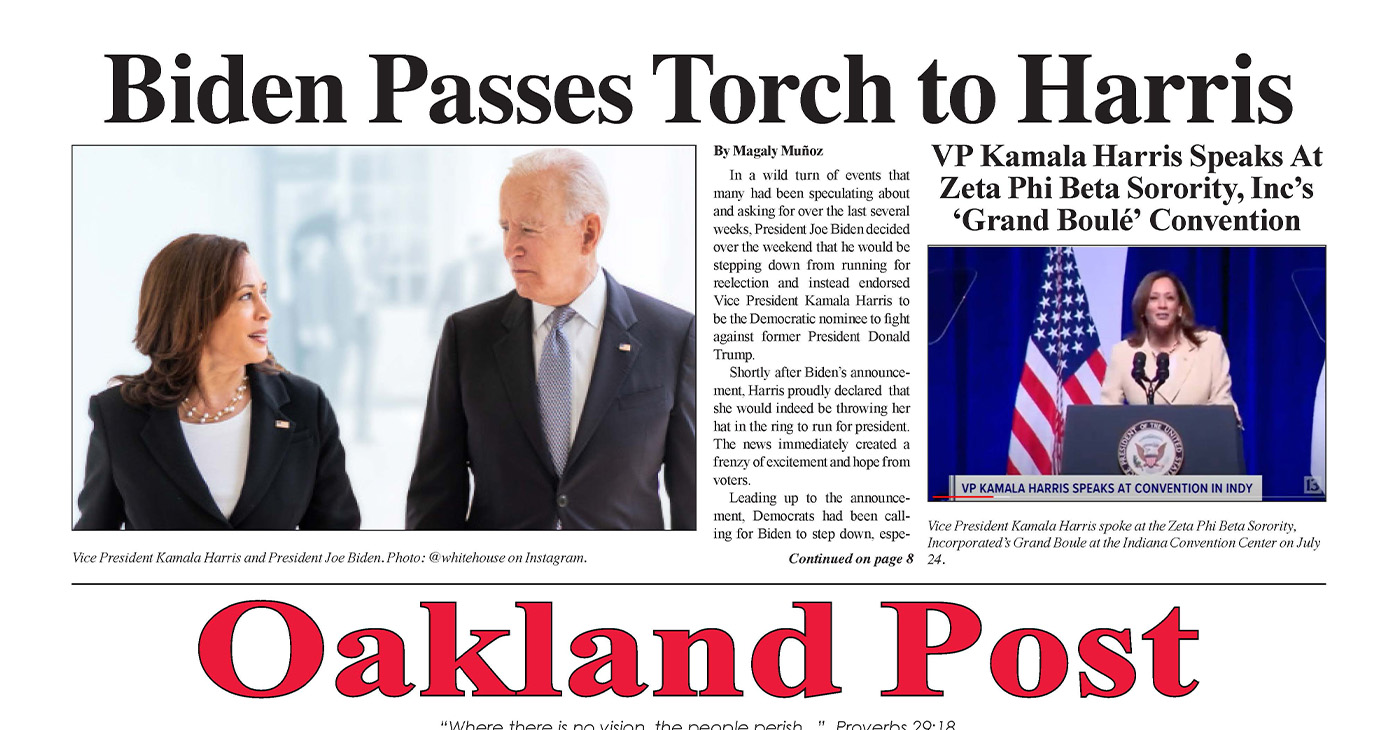Activism
School District Security Violently Clashes with Parents, Community at Parker Elementary School
According to a press release issued by the Parker protesters, “The security officers physically ejected several people and unlawfully detained one parent in the building in handcuffs, injuring the parent in the process. Within two hours, nearly 60 people from the public education community and neighborhood had amassed outside with a single demand: let go of this parent. After an hour, OPD arrived with four officers. As they opened the building, the group of people who were amassed outside entered the building and were met with excessive force by the OUSD security forces. More than 10 people sustained minor to moderate injuries, and two people went to hospital for treatment.”

By Ken Epstein
Oakland Unified School District security officers arrived at Parker Elementary School in East Oakland on Thursday, Aug. 4 to change the locks and clear people from the school.
Parker, located at 7929 Ney Ave. in East Oakland, has been occupied and kept open operating community programs for the last two months by community protesters, who are resisting the school board decision to permanently close the school at the end of May.
According to a press release issued by the Parker protesters, “The security officers physically ejected several people and unlawfully detained one parent in the building in handcuffs, injuring the parent in the process.
“Within two hours, nearly 60 people from the public education community and neighborhood had amassed outside with a single demand: let go of this parent. After an hour, OPD arrived with four officers. As they opened the building, the group of people who were amassed outside entered the building and were met with excessive force by the OUSD security forces. More than 10 people sustained minor to moderate injuries, and two people went to hospital for treatment.”
In a response to Oakland Post questions, OUSD spokesperson John Sasaki wrote: “OUSD staff went to Parker on Thursday and found all the people who had been inside the building had left the premises. So, staff changed the locks and set the alarm.
“Someone picked, cut, or otherwise broke through a lock to get back inside the building. They were removed. But unfortunately, individuals forced their way back into the building.”
Sasaki continued, “Parker K-8 School is now closed. The individuals at Parker have been and continue to trespass. We have directed them to leave from day one and have continued to do so on many other occasions. Of great concern is that the children that were onsite were sleeping in unsafe conditions and that the adults were running an unsafe and unlicensed childcare program. We continue to demand that they find other ways to safely and peaceably express their concerns.”
Parker protesters condemned the actions. “It was unthinkable that the district would send a group of poorly trained security —consultants — to injure, aggress, and antagonize a peaceful community where children were receiving services, located in a predominantly Black neighborhood of East Oakland, which already experiences disproportionate police violence,” the release said.
Parker activists say they are not leaving and will continue their fight to keep the school from being permanently closed and privatized.
Civil rights attorney Walter Riley, who represents the protesters, says that his investigation told the Oakland Post that description of the incident on Aug. 4 “were concerning in a number of ways.”
“The people had been there all summer, and the district had allowed them to continue. No notice of eviction had ever occurred. After locks were placed on the door, a protester made entry, not by breaking in but through a door with a key, as has been the case all summer,” said Riley.
The security agency employed by the district does not have the authority to use “self-help” (that is to physically evict people from the building). They are untrained, and the district is liable for their injuries.
Riley continued: “OPD officers, when they arrived, stood by, and watched unlawful physical attacks. One person was thrown headfirst into a wall by security causing significant injury. Another person, a candidate for school board and an active parent, was taken to the ground, a knee placed on his neck by security. He was brutalized, handcuffed, and held for up to two hours without medical aid for injuries to his wrist, neck, and face.”
Since May 25, the final day of classes of the 2021-22 school year, protesters have occupied Parker 24 hours a day, utilizing the space for a summer program for school-age children, youth empowerment initiatives, free food distribution, voter registration drives, and hosting community town halls and other events, according to protesters’ press statement.
This Wednesday, protesters held a press conference, accusing the district of political repression and retaliation by firing two educators who have been active in the fight against school closures and in defense of Parker school.
One of the two teachers who was fired was Craig Gordon, a 32-year veteran Oakland teacher and union activist. The other teacher who was fired was not named.
District spokesman Sasaki declined to comment on the firing of the two teachers. “We don’t comment on personnel matters,” he said.
Activism
Oakland Post: Week of July 24 – 30, 2024
The printed Weekly Edition of the Oakland Post: Week of July 24 – 30, 2024

To enlarge your view of this issue, use the slider, magnifying glass icon or full page icon in the lower right corner of the browser window. ![]()
Activism
Oakland Post: Week of July 17 -23, 2024
The printed Weekly Edition of the Oakland Post: Week of July 17 -23, 2024

To enlarge your view of this issue, use the slider, magnifying glass icon or full page icon in the lower right corner of the browser window. ![]()
Activism
Community Celebrates Historic Oakland Billboard Agreements
We, the Oakland Billboard Economic Development Coalition, which includes Oakland’s six leading community health clinics, all ethnic chambers of commerce, and top community-based economic development organizations – celebrate the historic billboard agreements approved last year by the Oakland City Council. We have fought for this opportunity against the billboard monopoly, against Clear Channel, for five years. The agreements approved by Council set the bar for community benefits – nearly $70 Million over their lifetime, more than 23 times the total paid by all previous Clear Channel relocation agreements in Oakland combined.

Grand Jury Report Incorrect – Council & Community Benefit
We, the Oakland Billboard Economic Development Coalition, which includes Oakland’s six leading community health clinics, all ethnic chambers of commerce, and top community-based economic development organizations – celebrate the historic billboard agreements approved last year by the Oakland City Council. We have fought for this opportunity against the billboard monopoly, against Clear Channel, for five years. The agreements approved by Council set the bar for community benefits – nearly $70 Million over their lifetime, more than 23 times the total paid by all previous Clear Channel relocation agreements in Oakland combined.
Unfortunately, a recent flawed Grand Jury report got it wrong, so we feel compelled to correct the record:
- Regarding the claim that the decision was made hastily, the report itself belies that claim. The process was five years in the making, with two and a half years from the first City Council hearing to the final vote. Along the way, as the report describes, there were multiple Planning Commission hearings, public stakeholder outreach meetings, a Council Committee meeting, and then a vote by the full Council. Not only was this not hasty, it had far more scrutiny than any of the previous relocation agreements approved by the City with Clear Channel, all of which provide 1/23 of the benefits of the Becker/OFI agreements approved by the Council.
- More importantly, the agreements will actually bring millions to the City and community, nearly $70M to be exact, 23 times the previous Clear Channel relocation agreements combined. They certainly will not cost the city money, especially since nothing would have been on the table at all if our Coalition had not been fighting for it. Right before the decisive City Council Committee hearing, in the final weeks before the full Council vote, there was a hastily submitted last-minute “proposal” by Clear Channel that was debunked as based on non-legal and non-economically viable sites, and relying entirely on the endorsement of a consultant that boasts Clear Channel as their biggest client and whose decisions map to Clear Channel’s monopolistic interests all over the country. Some City staff believed these unrealistic numbers based on false premises, and, since they only interviewed City staff, the Grand Jury report reiterated this misinformation, but it was just part of Clear Channel’s tried and true monopolistic practices of seeking to derail agreements that actually set the new standard for billboard community benefits. Furthermore, our proposals are not mutually exclusive – if Clear Channel’s proposal was real, why had they not brought it forward previously? Why have they not brought it forward since? Because it was not a real proposal – it was nothing but smoke and mirrors, as the Clear Channel’s former Vice President stated publicly at Council.
Speaking on behalf of the community health clinics that are the primary beneficiaries of the billboard funding, La Clinica de la Raza CEO Jane Garcia, states: “In this case, the City Council did the right thing – listening to the community that fought for five years to create this opportunity that is offering the City and community more than twenty times what previous billboard relocation agreements have offered.”
Oakland Billboard Economic Development Coalition
| Native American Health Center | La Clínica de la Raza | West Oakland Health Center |
| Asian Health Services | Oakland LGBTQ Center | Roots Community Health Center |
| The Unity Council | Black Cultural Zone | Visit Oakland |
| Oakland African American Chamber of Commerce | Oakland Chinatown Chamber of Commerce | Oakland Vietnamese Chamber of Commerce |
| Oakland Latino Chamber of Commerce | Building Trades of Alameda County | (partial list) |
-

 Arts and Culture3 weeks ago
Arts and Culture3 weeks agoRooted in Tradition: The Intricate History of Black Hair Braiding
-

 Bay Area4 weeks ago
Bay Area4 weeks ago“I Will Not Be Bullied,” Says Oakland Mayor Sheng Thao
-

 Bay Area2 weeks ago
Bay Area2 weeks agoPG&E Increases Rates While Bay Area Households Are Struggling to Stay Afloat
-

 Business3 weeks ago
Business3 weeks agoGov Newsom: Raising Fast Food Minimum Wage to $20 Pays Off as Jobs Multiply in Industry
-

 Activism4 weeks ago
Activism4 weeks agoOpponents of Mayor Sheng Thao Are Calling on Her to Resign Following FBI Raid
-

 Bay Area2 weeks ago
Bay Area2 weeks agoJuneteenth Mass Shooting Suspect Charge with Multiple Counts of Felony Assault by Alameda County DA Pamela Price
-

 Community1 week ago
Community1 week agoHundreds Come to Jehovah’s Witnesses’ Assembly Hall for Three-Day Program of ‘Good News’ in Fremont
-

 Activism4 weeks ago
Activism4 weeks agoOakland Coliseum Sale to AASEG: A Model for Community Development and Inclusion



















































